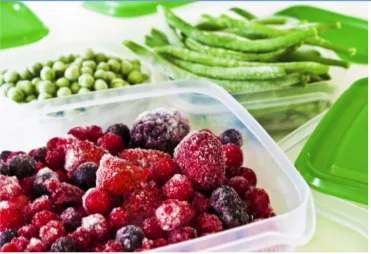Food Preservation: Freezing

As we plan for fall and summer, we are faced with uncertainty. While food systems are secure and safe due to USDA oversight, there can be food shortages of some products at times. Food preservation is a great way to ensure access to food, decrease food waste, decrease trips to grocery stores, and save money. However, it must be done safely.
Preserving food using recommended methods can prevent contamination and helps maintain quality. Molds, yeast and bacteria can cause food to spoil. Enzymes in fruits and vegetables must be inactivated to prevent flavor and texture changes. There are three main ways to preserve foods at home—canning, freezing and drying. The method you choose depends on which suits your needs and whether or not there are safe guidelines. For example, there are no guidelines for canning corn on the cob. Freezing is a safer choice. This is article 1 of 4 where food preservation methods will be discussed.
What do you think the easiest food preservation method is? I bet you are already doing it now! Freezing is a great place to start with food preservation. Freezing does not make food sterile, but it reduces the temperature of food so that bacteria, molds and yeast cannot grow. It also slows the actions of enzymes so that chemical changes do not occur. While you are limited by freezer space, this is a great way to preserve items that are not safe to can or dry.
Let’s discuss a few tips to ensure that freezing is safe and effective. Be sure to wash produce thoroughly in clean water. This is an important step to remove dirt and bacteria.
Next, blanch vegetables in water or steam to inactivate enzymes and kill microorganisms on the surface of the food. This is done by adding to boiling water and then to an ice bath to stop cooking and maintain texture. Be sure to cool foods before packaging and freezing, to keep your freezer at the proper temperature. Frozen items may expand or increase in size so you will want to check your recipe for the exact amount of headspace needed. It is best to use moisture-vapor resistant wraps and containers. Label your products with the name and date to use older items first and freeze at 0 F or below. Frozen items are safe for long periods, but quality may decline.
What questions do you have about freezing? Do you have a favorite item to freeze? Send questions or recipes to aphill34@utk.edu and I will answer some later in the summer in article 4. Check out nchfp.uga.edu/how/freeze.html for more information on freezing, or give us a call at the Extension office (865-992-8038) to chat food preservation. We will offer hands on canning classes when safe to do so. Alyshia Victoria, UT Extension Agent Union County with information developed by Dr. Janie Burney, PhD, RD, Professor/Nutrition Specialist.
- Log in to post comments